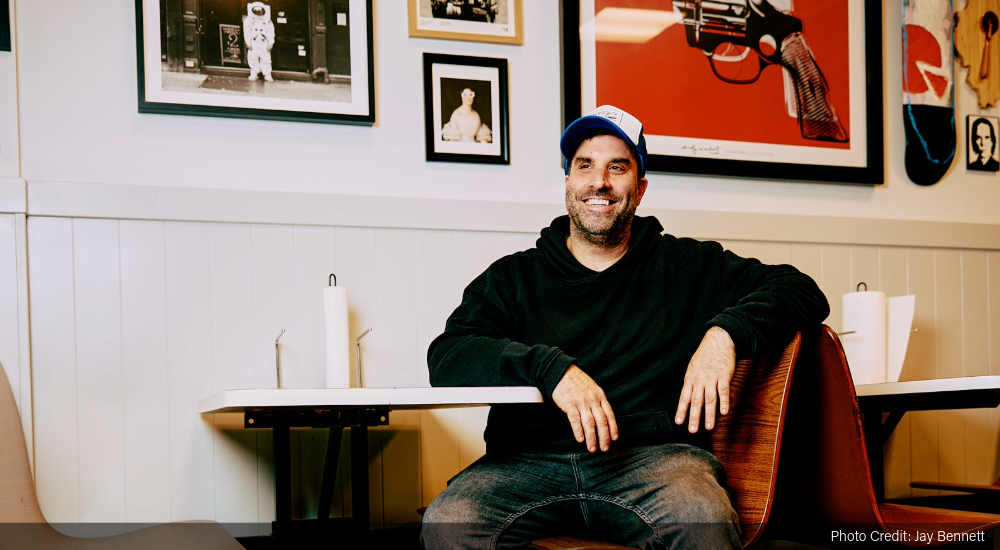Milly’s Pizza in the Pan
Chicago, Illinois
Concept:
We are a small pizzeria with two locations: one in Chicago, Illinois, and one located in a nearby suburb, Berwyn. We only make pizza, and we make a limited number of pizzas per day. People preorder in the morning by selecting a time slot and come pick up their pizza for the time slot that they chose.
Pizza Style & Dough:
At Milly’s, we only make pan pizza. It is similar to Detroit in that it has a frico crust, but the dough is denser and isn’t as airy. Another distinct difference is that we make our pizzas in a round pan instead of a square pan. Cheese is on the bottom, and we line the edges of the pan with mozzarella cheese slices. The sauce is an uncooked sauce that goes on top. Unlike most traditional deep dishes, which have the toppings on the bottom, we place our toppings on top.
As far as the dough goes, we use a blend of whole wheat as well as bread flour. We also use a starter called a poolish, which is equal parts flour and water with some commercial cake yeast added. In addition to the starter, we also let our dough autolyse for an hour. This allows for the flour to become more hydrated and allows for the gluten structure to start forming.
We use around 65-percent hydration. Once the autolyse is complete, we add salt as well as oil and mix for a very short period of time. We then let the dough ferment for at least three hours but as many as six hours, depending on the time of year. After the bulk rise, we divide the dough and place it in individual dough tins, then place it in the fridge, where we cold ferment the dough for about 36 hours.
How did you create your unique pizza?
The pizza that I am making is inspired by the late Burt Katz, who brought this style of pizza to Chicago. Our dough process is different from his, and I would say our toppings are unique. I spent a lot of time creating our dough recipe, and I am tweaking on almost a daily basis.
The flavor combinations of the toppings are really good. I also try to put a lot of thought into when I’m creating a new pizza. Sometimes it will take me up to a month of trial and error before I’m comfortable putting out a pizza. It has to taste amazing and also be visually appealing.
I am really inspired by the techniques of world-class bread makers and try to bring some of that same care and precision to my dough. For toppings, I always try to find one unique ingredient – like peppadew peppers – and build flavor combinations around it, as I did with the “Craigslist.org” pizza. We use an uncooked sauce so the tomato flavor is vibrant. It’s a pizza that looks heavy but eats light.
What were the advantages and drawbacks of starting as a ghost kitchen?
The biggest advantage to starting a ghost kitchen was the cost. I think I started my ghost kitchen for around $3,000. I just had to buy the pans, scale and other basic pizza tools. The kitchen provided me with all the other things I needed, like a dough mixer, oven, hood and three-compartment sink. The start-up cost was really low. It’s also a great way to test your product in a market. It’s a great way to see if the product you are producing is something that can be scaled up.
The big downside is having a storefront gives you visibility. People driving by or walking by can see there is a pizzeria, and chances are pretty high they will order. I can’t tell you how many times people would get lost trying to find my ghost kitchen. Brick and mortar also allows people to eat the pizza hot and fresh out of the oven instead of it steaming in a pizza box, which – as every pizza maker knows – greatly affects the end product.
What were the logistics of relocating out of your uptown location?
Deciding to leave Uptown was a difficult decision, as we had grown a reputation there and I’m sure some people felt we were abandoning them. We had the opportunity to bake our pizzas in a very rare oven that hadn’t been turned on for about 15 years. The restaurant before us didn’t use it, so it was not operational. Fixing the oven took some time and some expertise. Moving all our heavy equipment like dough mixers and fridges was not easy. Converting the restaurant to a pizzeria took about six weeks. We even went so far as to find a new tenant for the old space to help out our landlord. We have a lot more space at our new location, which means we can scale up our operation.
 Read the November 2025 Issue of Pizza Today Magazine
Read the November 2025 Issue of Pizza Today Magazine
This month, we are diving deep on all things cheese. Learn how the fluctuating commodities market can impact the price you pay for mozzarella and other block cheeses. Then, find out how operators are using craft beer cheddar, gorgonzola and plant-based cheeses made from cashews, coconuts, peas and other bases to create pizzas that are visually and gastronomically stunning. Round out your education for the month by brushing up on pizzeria art, SOPs and winter squash.
Check out the full Digital Edition – Pizza Today November 2025.



